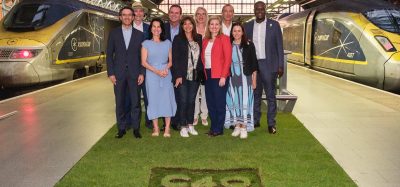Continuous Nordic rail development
Posted: 1 August 2008 | | No comments yet
A round-up of the Nordic Rail Infrastructure conference, organised by Global Railway Review, which took place at the Marriot Hotel in Copenhagen, Denmark on 16 and 17 June 2008.
A round-up of the Nordic Rail Infrastructure conference, organised by Global Railway Review, which took place at the Marriot Hotel in Copenhagen, Denmark on 16 and 17 June 2008.
On 16 and 17 June 2008, Nordic Rail Infrastructure, a conference organised by Global Railway Review, took place at the Marriot Hotel in Copenhagen, Denmark.
The aim of the conference was to bring speakers and delegates together to enjoy informative presentations concerning major projects and developments within the Nordic region. The conference was chaired by two important industry peers; on the first day Morten Søndergaard, Programme Director of Banedanmark and on the second day Kim Andersen, Assistant Director of Technical Operations and Maintenance of Banedanmark.
Welcoming delegates on the first morning of the conference was Jesper Hansen, CEO of Banedanmark; the conference hosts. In his welcoming speech, Mr. Hansen expressed his eagerness to listen to “intimate discussions” over the course of the conference and thanked all delegates and speakers for their attendance. Mr. Hansen went on to emphasise the importance of regional growth in our industry and that Banedanmark is looking forward to the future with promising developments and potential for achieving a larger market share. Mr. Hansen declared that there is “huge potential” for all railways and suggested that there are many advantages for our sector which everyone must take onboard to gain growth in our society.
Mr. Lennart Westberg, CEO and Project Manager of Botniabanan AB was first to present to delegates with a presentation concerning the construction of the Botniabanan project. Mr. Westberg explained that the project is now just three years away from completion, and he concluded his presentation by explaining how the project is financed.
Next to take the stand was Mr. Harald Nikolaisen, Project Manager of the Skøyen-Asker Project of Jernbaneverket. Mr. Nikolaisen’s presentation focused on the rail corridor West of Oslo and developments of new tracks for the region and the benefits that they will bring.
Kjell-åke Averstad, Project Manager of the Stockholm City Line ‘Citybanan’ was next to make a presentation about the important construction of a 6km railway tunnel in Stockholm which consists of two tracks. Mr. Averstad provided a detailed presentation for delegates, explaining how the project is being constructed and the benefits it will bring to solve the capacity problem for rail traffic through Stockholm.
Eskil Sellgren, Deputy Managing Director of WSP, one of the company sponsors of the conference, took to the stand next for an overall presentation of WSP and details of major Swedish projects the company are involved with including the Malar Line in Stockholm, the City Line in Stockholm and the Arlanda Express in Stockholm.
A panel discussion made up of the morning speakers took place just before lunch which gave delegates the opportunity to ask questions to the speakers and for them to elaborate on certain aspects of their presentations.
Afternoon presentations came from Gunnar Sibbmark, CEO of Europakorridoren AB and Massimo Costa, Directorate-General of Energy & Transport of the European Commission, before Morten Søndergaard (Chairman of Day One) made his own presentation concerning the development of railway telecommunications and signalling. Continuing this theme was a presentation from Christian Utasch, Director of Sales Engineering Train Control International of Siemens; another company sponsor of the conference.
The topic of Mr. Utasch’s presentation was ETCS projects – from tender to operation. Mr. Utasch took the stand and thanked everyone for having the opportunity to present the challenges and experiences plus comments of success factors. Mr. Utasch concluded his presentation by explaining the importance of using pilot lines and test trains.
Martinus Grimsmo, Technology Manager at Jernbaneverket was next to take the stand and spoke about Norwegian opportunities for rail telecommunications. Mr. Grimsmo addressed many aspects including the use of GSM-R and GPRS for transport of block telephone and signalling info, plus on-board functionality solutions on GSM-R platforms.
The last three presentations of Day One came from Aki Härkönen, Manager of Rail Data Unit at RHK who made a presentation about Finish Rail Signalling, Poul Frøsig, UIC Project Manager ERTMS/ETCS & ERTMS Regional, who spoke about UIC ERTMS REGIONAL project with an overview, background and future details and Peter Elestedt, System Expert at Bombardier Transportation, who spoke about INTERFLO 550.
Another panel discussion made up of afternoon speakers took place, before a networking drinks reception to end Day One.
Presentations on Day Two began with Mats Onner, ERTMS Manager at Banverket, followed by Kim Andersen of Banedanmark who gave a presentation about the history of Banedanmark and the chaotic situation it was faced with in 2005. Mr. Andersen went on to explain that the company has seen a turnaround in its operations thanks to a government agreement in 2006 and the funding of a 4.7 billion DKK renewal plan.
To take presentations into the afternoon of the second day, delegates listened to three presentations from Nordic Transport Ministries to learn what role they play in the development of networks.
First to take the stand was Fredrik Birkheim Arnesen, Deputy Director General of the Norwegian Ministry of Transport and Communications. He discussed the Norwegian Ministry’s role in the development of the Norwegian railway network and congratulated the conference hosts for organising an excellent conference before explaining the current strategy for development of the transport sector and how the Ministry coordinates such plans.
The second presentation came from Hans Brandstrom, Director Division for Infrastructure of the Swedish Ministry of Enterprise, Energy and Communications. He gave light on the Swedish Ministry’s role in maintaining the importance of transport networks and explained many aspects including climate change and the fact that there are still intense discussions and investigations ongoing concerning the environment.
To end the Ministry presentations, Petri Jalasto, Senior Advisor at the Finnish Ministry of Transport and Communications, took the stand and declared it was “nice to be at the conference to give a presentation from Finland’s point of view”.
A panel discussion between the three ministry representatives took place before lunch and many topics were raised, including market share growth expectations, progress and development and increasing capacity as a whole.
The penultimate presentation was from Martin Munk Hansen, Director of Rail Projects at the National Rail Authority of Denmark. He gave a company overview and explained some status updates of concepts and major projects plus sharing information concerning comprehensive development strategies.
The final presentation of the conference came from Svend Poulsen, Project Director of Atkins Danmark A/S who explained the rail consulting services of Atkins and then went on to share some information about the development of Nordic infrastructure – explaining the challenges and finally giving an overview of major projects in Denmark, Sweden and Norway.
Global Railway Review would like to thank the Hosts, Banedanmark and the sponsors Atkins Danmark, Bombardier, Siemens and WSP, for contributing to a successful conference and we look forward to seeing delegates again at future Global Railway Review conferences.
If you would like to receive a copy of the CD-Rom containing the presentation of Nordic Rail Infrastructure 2008, at a cost of £127.00 + VAT, please contact [email protected] or phone +44 (0) 1959 563 311.







